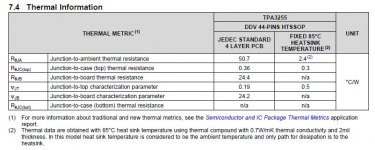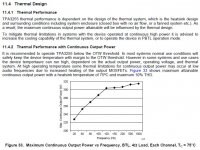Really interesting Feedback and makes sense )
A warm Heatsink = It is a heatsink that plays its role well .... had to think about it)
In any case, I had no problem on my side, neither with my 3E Audio, nor with my Shui Yuan ... so I'm not in the best position to talk about it)
A warm Heatsink = It is a heatsink that plays its role well .... had to think about it)
In any case, I had no problem on my side, neither with my 3E Audio, nor with my Shui Yuan ... so I'm not in the best position to talk about it)
That is an excellent point. A cold heatsink might even be a bad sign.
I often take heatsinks off to sand down the bottom surface to a flat and mirror polished finish. The smoother the surface, the greater the contact area and thus better heat transfer.
This process is called 'lapping', and it's not difficult to do. There's ton's of information on this in the PC building community, so if anyone is interested just google 'cpu lapping'. It just takes a little patience starting at 400 grit sandpaper for wetsanding and working your way up to 2000 grit. And of course replacing the stock heatsink paste with some better quality one.
One thing I did notice about the Shui Yuan heatsink is that it is significantly smaller and has less surface area compared to the 3e heatsink. So if they both would receive the same amount of thermal energy, the Shui Yuan one should be significantly hotter. That also might be a sign that the heat transfer between chip and heatsink might not be optimal.
I often take heatsinks off to sand down the bottom surface to a flat and mirror polished finish. The smoother the surface, the greater the contact area and thus better heat transfer.
This process is called 'lapping', and it's not difficult to do. There's ton's of information on this in the PC building community, so if anyone is interested just google 'cpu lapping'. It just takes a little patience starting at 400 grit sandpaper for wetsanding and working your way up to 2000 grit. And of course replacing the stock heatsink paste with some better quality one.
One thing I did notice about the Shui Yuan heatsink is that it is significantly smaller and has less surface area compared to the 3e heatsink. So if they both would receive the same amount of thermal energy, the Shui Yuan one should be significantly hotter. That also might be a sign that the heat transfer between chip and heatsink might not be optimal.
I have two of the TI 3255EVM boards. I use both of them with 48V without any heat issues. The heatsink is nothing special, about the same size as for the Shui Yuan board. One of them I use in my main system. It get just lukewarm, I can hold my fingers on the heatsink indefinitely provided that the case has resonable cooling.
I just now measured the current draw and online with connected preamp it consumes 94 mA. In reset mode that is 36 mA.
This is for the whole board including the 12V section and is very much inline with the specification for the 3255. This translates to less that 5W into the heatsink.
I cranked the sound from the TV up quite a bit before the current draw raised to and above 100 mA.
I would say that the issue is clearly with the 3e audio board. I've seen all those reports how it get to hot over 36 volts. I don't know what wrong with that board and I'm really not interested in finding out.
I just now measured the current draw and online with connected preamp it consumes 94 mA. In reset mode that is 36 mA.
This is for the whole board including the 12V section and is very much inline with the specification for the 3255. This translates to less that 5W into the heatsink.
I cranked the sound from the TV up quite a bit before the current draw raised to and above 100 mA.
I would say that the issue is clearly with the 3e audio board. I've seen all those reports how it get to hot over 36 volts. I don't know what wrong with that board and I'm really not interested in finding out.
Last edited:
My 3e running with 38v have 46 degrees celcius measured in center of heat sink playing at low volume with open case.
Pretty hot I think if it matter.
If one can hold their finger on the heat sink for a couple of seconds, without burning their finger, it is probably fine (<60C). TI planned for excessive heat.
One can calculate the thermal resistance of the current heat sink and the TPA3255 device power dissipation & one can decide if it is adequate.


Have you calculated the expected dissipation at 38V? I would think it´s easily >2W and the heatsink ist not that big (although bigger than some).My 3e running with 38v have 46 degrees celcius measured in center of heat sink playing at low volume with open case.
Pretty hot I think if it matter.
That´s good practice if the other side is plane too but keep in mind that the "weakest link" in the heat transfer equation will dictate the overall resistance.I often take heatsinks off to sand down the bottom surface to a flat and mirror polished finish. The smoother the surface, the greater the contact area and thus better heat transfer.
This process is called 'lapping', and it's not difficult to do. There's ton's of information on this in the PC building community, so if anyone is interested just google 'cpu lapping'. It just takes a little patience starting at 400 grit sandpaper for wetsanding and working your way up to 2000 grit. And of course replacing the stock heatsink paste with some better quality one.
In that case that would be the "chip side".
If the chip doesn´t sit 100% leveled on the board, your lapping will be pretty useless and usually chips don´t sit that perfectly level.
Also: how is the heatsink mounted? Are the threads straight etc...
You see: in the end it´s probably best to have some compensatory element to optimize heat transfer. Something like a "gap pad" which is an insulating heat transferring "foil" which you can get in different thicknesses.
All that said: We probably listen to a good 1W on average so in the end that doesn´t matter really that much in a "living room setting" and a little bit of thermal paste is usually fine.
Thanks... then I have to look for another good TPA3255 that is prepared for balanced connection. Is there a recommendation?
3e Audio, can select both SE and DIFF inputs:
TPA3255 2x260W 2Ch Class D Audio Amplifier|Amplifier| - AliExpress
TPA3255-2CH-260W | 3e Audio
Thanks... then I have to look for another good TPA3255 that is prepared for balanced connection. Is there a recommendation?
Depends how much you want to spend but you could check out the 3e-Audio board which are about 50 dollars plus small amount for shipping. Check out the 3e-Audio AliExprees store.
There are of course many other TPA3255 boards going up to many hundreds of dollars. Check out the posts by Danny as he has played with most of the currently available boards.
I did an simple comparison of the two boards earlier in this modification thread. See post #10.
Shui Yuan Audio TPA3255 Modification Thread
James
Last edited:
Douk Audio have a "UK warehouse" at ebay but they are not stocked so well at the moment (the germany warehouse might do shipping-wise).I am struggling to find a case where the shipping costs to the UK are not 3x or 4x the cost of the case on AliExpress !!
I´ve ordered from them and although it´s more expensive, it´s still cheap for what it offers. Got an amp case with heatsinks from them for ~70€ incl. AC-socket. All solid and thick aluminium plates.
Great deals from doukmall in UK-Warehouse- | eBay Shops
Tolle Angebote fur Aluminum-Chassis- bei doukmall | eBay Shops
I first had the Shui Yuan TPA3255 in mind as a solution for me, but this turned out to be a fallacy. In my chain, I route the signal via an audio PC through an 8-channel audio interface with balanced outputs. For this I want two 4-channel amps with balanced inputs.
Thanks for the answers. I don't want to hijack this thread and will therefore open a separate thread, read threads beforehand to get to know the experiences of experienced users.
Thanks for the answers. I don't want to hijack this thread and will therefore open a separate thread, read threads beforehand to get to know the experiences of experienced users.
Soit vous devez acheter une paire d'enceintes supplémentaires .. soit couper la carte en deux.
You will change the sound with WIMA MKPs across the FW buffer caps! It will sound more open but also or maybe uneven - its a matter of taste.
BTW, the Nichicon VZ main caps are a very clever choice cos they do sound gentle almost tube like, if you want more definition and tighter sound change to Nichicon FG.
The 3e audio board has Nichicon ES BiPolar caps, I dont like them. FW, FG, KZ, Silmic II do sound better IMO. I would never bypass good caps with MKPs. But large KZ, FG, FW with smaller Silmic II is very good cos it smoothens the highs quite a bit. IE: 10uF KZ & 1uF Silmic II.
BTW, the Nichicon VZ main caps are a very clever choice cos they do sound gentle almost tube like, if you want more definition and tighter sound change to Nichicon FG.
The 3e audio board has Nichicon ES BiPolar caps, I dont like them. FW, FG, KZ, Silmic II do sound better IMO. I would never bypass good caps with MKPs. But large KZ, FG, FW with smaller Silmic II is very good cos it smoothens the highs quite a bit. IE: 10uF KZ & 1uF Silmic II.
Last edited:
- Home
- Amplifiers
- Class D
- Shui Yuan Audio TPA3255 Modification Thread

